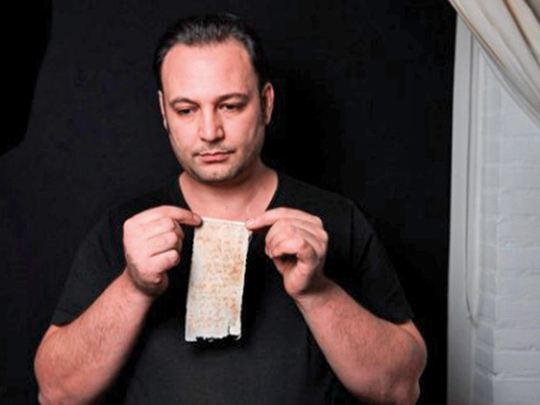
Washington: Between 2012 and 2013, Mansour Omari spent a hellish year in a number of underground Syrian prisons.
The activist and journalist was blindfolded and crammed into a dark cell with dozens of other detainees. Roaches crawled across the floor. Prisoners itched and scratched with open wounds and sores. Their gums bled because of malnutrition. “The smell,” Omari said, “was unbelievable.”
But even in their depths of despair, they clung to a form of hope.
Omari recalls how he and some fellow prisoners sought to keep track of everyone around them: They collected the names of 82 inmates locked in the secret government facility where they were detained. Then they mixed their own blood with rust filings to create ink, used scavenged chicken bones as quills and carefully wrote down all the names and numbers they had gathered on rough strips of fabric. These were hidden inside a shirt that Omari put on the day he was released.
Those five pieces of cloth are now on display in a chilling exhibit at the U.S. Holocaust Memorial Museum in Washington. Framed in individual display cases, they look like ancient artifacts, faded canvases etched with runes from a distant past. But they tell a very modern story.
Visitors to the building, which chronicles the horrors of the 20th century’s worst genocide and the context of how it began, are now confronted with a contemporary calamity: The ongoing war in Syria, which has claimed the lives of about a half-million people, forced 11 million people to flee their homes and upended one of the Middle East’s most venerable societies.
“Syria: Please Don’t Forget Us” also is a pointed critique of the regime led by Syrian President Bashar Al Assad, which is an accomplice to the ravaging of the nation and the disappearance of countless of dissidents and ordinary civilians into a network of clandestine prisons and torture houses. It sits alongside another installation on Syria featuring the photography of a former Syrian military police photographer, whose images show how detainees were maimed, their eyes gouged out and limbs gored.
“So many people go through this museum and wonder, ‘What would I have done if I was living in 1930s Germany,’ “ Cameron Hudson, director of the museum’s Simon-Skjodt Centre for the Prevention of Genocide, told us. “What we want them to think is, ‘I’m living in 2017, and this stuff is going on around me.’ “
Sadly, though, museum-goers can only bear witness - and outside the building there seems to be little appetite to do anything more.
To many in the West, the war in Syria is on the wane.
Al Assad, backed by both Iran and Russia, is secure in Damascus and recapturing bombed-out cities across the country.
He and Russian President Vladimir Putin seem to be in a strong position to steer the political process that could bring a putative end to the conflict.
Daesh has been chased out of all its major strongholds, its ranks depleted.
Peace, though, is nowhere in sight.
Daesh may have suffered defeats on the battlefield, but it remains a deadly threat to civilians in many countries. Moreover, the conditions that led to its rise have hardly been addressed.
“Governments like to talk about Daesh in terms of metrics, numbers, cities taken. What we forget is that Daesh is more than a presence on the ground. It is a political force, an ideological force, and it says something about the world that people across Syria and Iraq have been living in,” Tobias Schneider, an international security analyst, told my colleagues. “We are not one step closer to solving those politics.”
Of course, for Omari and other dissidents, solving those politics involves reckoning with what they see as the real source of Syria’s undoing - Al Assad.
The direction of the war took a pro-Damascus turn after Russia joined the regime’s relentless bombing of rebel-controlled areas in 2015.
But “it’s not only the bombings which are hurting us,” Omari told reporters on the sidelines of the exhibition.
He points to the ruthlessness of Al Assad’s security state, which stifled free expression for decades, ransacked the offices of his media organisation and arrested him in February 2012.
“Real peace will be when you have justice,” Omari said, gesturing quietly to the possible end of Al Assad’s rule.
When he got out of prison and eventually fled the country to Sweden, Omari carried with him the whispers and fears of the men he left behind in prison.
“People who were around me, the detainees, they had this hope that when I go out I could help them,” Omari said in testimony recorded for the exhibit.
“And I’ve been working on that. Trying to convince people, organisations, governments to do anything for them. There are millions of Syrians that now need justice. The value of these shirt pieces, I hope that it plays a part in holding some people accountable.”
In the meantime, he wants his publicizing of their names and ordeal to show that “I somehow fulfilled my promise to them.” Real justice may be far away, but Omari still believes it will come.
“For me and many other Syrians, we cannot live without hope,” he said.












